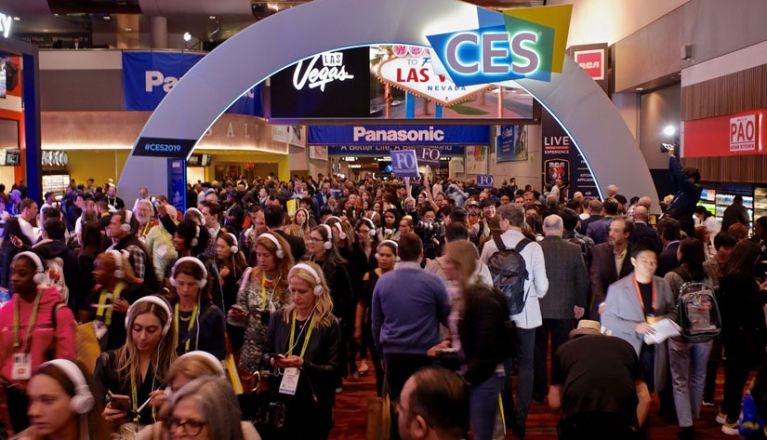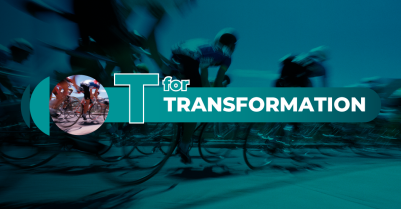-
View article
 #ACT2028
#ACT2028Olivier Gavalda, Chief Executive Officer of Crédit Agricole S.A., explains ACT 2028
2025/11/18
- #Innovation
- 2019/01/25
- 0
-
64
Back from Vegas
The Consumer Electronics Show (CES) would border on exasperating (four days isn’t enough to see even 10%), if it weren’t the only place in the world where you can get a comprehensive view of our technological future — a vital perspective if you want to position yourself as an innovator. The following themes were the talk of the show.

A show to match its city: absolutely outrageous
Navigating one’s way through it is an endurance test, but mostly a synthesis test, as the innovations presented touch on so many different areas and require such varied expertise. CES can be summed up in four figures: close to 200,000 attendees vying over the equivalent of 250 football fields of floor space and welcomed by 4,000 exhibitors and now 900 start-ups.
Healthtech: these objects care about your health
Significant breakthroughs have been made in healthcare for a wide range of pathologies. A few examples can be found below.
Ultrasound heads now cost almost nothing to make, and several manufacturers offer self-diagnosis through these accessories. Given AI's capabilities, we should soon be able to have an ultrasound at home and receive a highly reliable analysis or strikingly realistic 3D images in real time!
In the future, we will also have to be prepared for the FocusFit from BrainCo, which is a kind of headband that uses electroencephalography (EEG) technology. It can be used to accurately measure your level of concentration on a specific subject and to perform commands via an app.
UrgoTech is more like a diadem which, in combination with an app, trains your sleep brainwaves in order to reduce the time it takes to fall asleep and improve the quality of your sleep.
“Mirror, mirror, on the wall, who’s the fairest of them all?” If the evil Queen in Snow White had had a CareOs smart mirror, not only would she have received an accurate answer to her question but she would have also had access to personalised coaching, a visual acuity test, virtual testing of beauty products, etc. In short, she would have increased her chances of competing with the princess…
Devinnova takes care of the heart. This connected object is a medical device for the prevention of cardio-respiratory and vascular risks. It measures information such as heart rate, blood pressure, hydration and respiration rate. It can predict a heart attack two months before it occurs. But that’s a long way from saying it's not stressful...
And while we're on the subject of stress, HYPNO VR is a software solution that uses virtual reality headsets to perform anaesthesia under hypnosis in order to decrease patients’ anxiety during painful procedures. Designed by hypnotist-anaesthetists, the solution appears to be reliable and has already been rolled out to several hospitals.
Transport is shifting gears
Heading towards MaaS
In transport, one of the hot topics of the day is MaaS (mobility as a service), which aims to make life easier for public transit riders by offering a single subscription and platform for planning “multimodal” itineraries and making reservations all in one place. With MaaS, the only thing you have to worry about is where you would like to go and when. Like a personal assistant, a smartphone app then suggests the fastest, least expensive and easiest routes, which may combine multiple modes of transport be they public, private, or shared. MaaS also applies to two-wheelers, which may be equipped with a BISECU anti-theft device. You control this lock from your mobile phone and can therefore share it with others. In the meantime, Harley Davidson has gone electric…
Self-driving vehicles
Some of the models presented have already reached level 4, which is the highest level. At that level, drivers are free to do other things than drive the car. They do not need to be ready to take control…
One example is the M-Byte SUV, the Chinese Tesla, on which production will officially begin at the end of 2019. Rest assured, outdoor laboratories are planned to test self-driving vehicles on closed courses under real traffic conditions.
Conquering space
Autonomous vehicles are also in the air: examples include the ElectraFly drone-like flying motorcycle which has a range of 50 km for a 150 kg load, and could be for sale as soon as 2021, and the Bell flying taxi, which will be ready for take-off in 2025.
Security is a crucial area
It’s a bit of a vicious circle: the advent of all-digital systems, which aim to simplify and protect the life of their users, simultaneously require continuous improvements in data security, a service provided by Green Hills Software. This company certifies the level of security of the algorithms needed to operate self-driving cars.
The same holds true for French start-up Keopass, which has developed a universal biometric key that replaces passwords with digital fingerprints and works with all connected devices (PCs, Macs, smartphones, tablets, etc.) with Bluetooth Low Energy and USB connectivity.
It is also the case for Shield, marketed by Linksys, a box that helps protect your WiFi network from viruses, malware and other intrusions.
A fascination with virtual reality
This year, sector players presented new interfaces that are much more intrusive. One example is haptic interfaces, which do not have a connection and could be defined as a sort of “force feedback”, i.e. the ability to feel physical interactions with a virtual environment.
Users can feel, with their hands, a wall in front of them, a doorknob, etc. Many manufacturers are interested in this, including Apple which filed a patent for a haptic glove two days before the start of CES. But a Eureka Park start-up has done even better: by means of a simple transmitter placed in front of them, users feel virtual interactions as though they were physically real.
Ultrahaptics is proposing to use this contactless technology in car dashboards, making it easier and safer to change the car’s settings and control its functionalities, since it uses simple gestures rather than precise finger movements.
Those innovations that have lost their appeal or are slow to take off
While artificial intelligence is still everywhere you look, people are talking about it less. Other areas where enthusiasm is waning a bit are 3D printing, fitness trackers, electronic chips (even though they are smaller), cameras (even though they are more powerful), smartphones (even though they perform better) and robots, which no longer capture the imagination. On the telephony side, news about 5G is long overdue.
Dream a little...
CES is primarily a high-tech show for consumers. To dream and discover the objects of the future, you have to visit the booths of the major manufacturers (Sony, LG, Samsung, etc.). That’s where things are really happening.
These booths all displayed bendable 8K screens with an astonishing sense of realism and LG had a TV you could roll up in the sound bar (very impressive). Virtual reality was incredible at these booths, in terms of both image and immersive sound.








